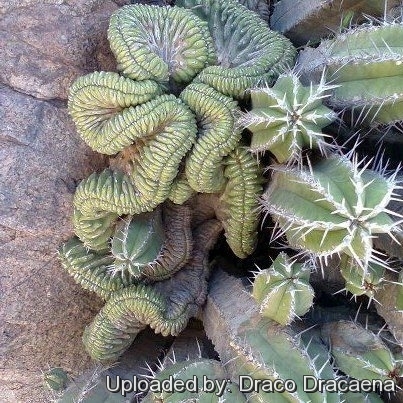Accepted Scientific Name: Euphorbia officinarum subs. echinus
Euph. Mau. Suppl. 447 1960

Euphorbia officinarum subs. echinus f. cristata Photo by: Draco Dracaena
Crested habit, Agadir Auguejgal, Anti Atlas, Tiznit, Morocco.
Origin and Habitat: Morocco. It is endemic to the southwest of the country, where it grows in lowland and coastal habitats as well as high up in the Anti-Atlas.
Habitat: Sub-Mediterranean Shrubland and degraded dry forest in the littoral region of the stone-desert of Tindouf and Zemmour, often on rocky hillsides and pebble and gravel lower scree slopes, but also, on shallow rocky soils and in wind-swept places near the sea. The succulent water-storing stems and its low transpiration rate ensures that sufficient water is retained until the next rains. It is quite common and is often found along with Euphorbia beaumierana, Euphorbia regis-jubae, Euphorbia resinifera, and Senecio anteuphorbiumSN|19323]]SN|19323]].
Synonyms:
See all synonyms of Euphorbia officinarum
Common Names include:
BERBER (Tamaziɣt , Tamazigh): Tikiwt
Description: Euphorbia officinarum subs. echinusSN|13374]]SN|13374]] is a spiny, cactus-like, succulent shrub densely branched from the base, with up to 100 branches forming compact, hemispherical or variously shaped, bunches reaching about 1 metre tall, but perhaps 3 metres across, so that they resemble a giant spiny hedgehog crouching the ground.
Crested form: The crested form (Euphorbia officinarum subs. echinusSN|13374]]SN|13374]] f. cristata) is a nice crested succulent forming odd sculptural shapes. Its stems fan out, some will form stable crests while others just cluster over one another. The crested form can also get very big making a spectacular specimen. Older crested plant can reach a considerable size (up to 1 m in diameter, or more).
Stem: Fan shaped with angled, irregular ribs.
Spine shields: 4-5 mm in diameter, pale buff, joined in a horny margin.
Spines: Slender, paired, very pointed, 4-10(-15) mm long, about 6 mm apart.
Inflorescence: Solitary cymes, 1- to 2-forked; peduncles short.
Flowers: Cyathia 3-4 mm on diameter, dull red; Nectar gland elliptic, dark red.
Fruit: 3-lobed capsules, subglobose, about 4-5 mm in diameter on slender curved stalks.
Seeds: Irregularly wrinkled.
Subspecies, varieties, forms and cultivars of plants belonging to the Euphorbia officinarum group
Cultivation and Propagation: Euphorbia officinarum subs. echinus f. cristata needs bright light to partial shade for best appearance. It responds well to warmth, with its active growth period in the late spring and summer months. Water thoroughly when soil is dry to the touch during active growing season (more than once a week during hot weather) In the winter months, waterigs should be suspended or restricted to once over the winter. The most common failure in growing this plant is over watering, especially during the winter months. Likes porous sub-acidic substrata (pH 6) with adequate drainage. Very tender, protect from frost.
Propagation: It is propagated by cuttings. It is recommend taking Euphorbia cuttings in Spring/Summer when the plant is growing so that they have a better chance of success. They key is heat & good air circulation. These cuttings should be dipped in Hormone powder (but it is not needed) and left for a period of 3-4 weeks to callous. Then pot the cutting and don't water ( or kept slightly moist) until rooted. These will root just fine, if you can put the pot outside in the summer, or put pot on a heating pad.
Crested growth: Unlike 'monstrous' varieties of plants, where the variation from normal growth is due to genetic mutation, crested growth can occur on normal plants. Sometimes it's due to variances in light intensity, or damage, but generally the causes are unknown. A crested plant may have some areas growing normally, and a cresting plant that looks like a brain, may revert to normal growth for no apparent reason. If you have any of the crested part left you need to remove the normal growth and leave the crested part behind this will need to be done regularly.
Warning: As with all other Euphorbias when a plant get damaged it exudes a thick white milky sap known as latex. This latex is poisonous and particularly dangerous for the eyes, skin and mucous membranes. So pay extreme attention not to get any in your eyes or mouth. Cultivated plants must be handled carefully. Watt & Breyer-Brandwijk (1962) described this plant as being virulently poisonous.










